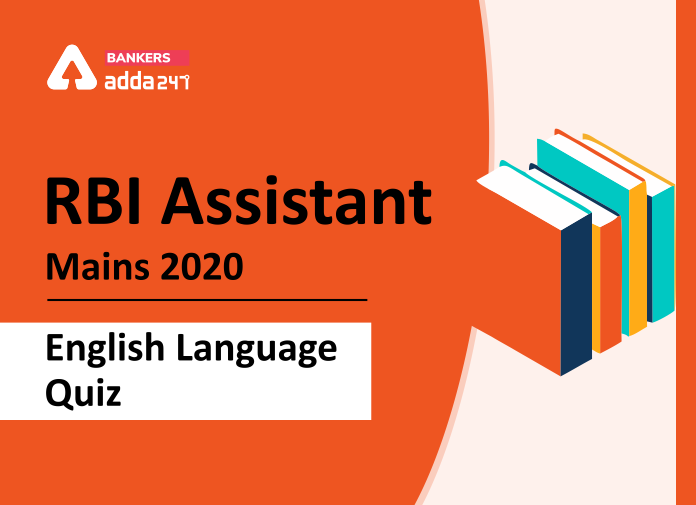Table of Contents
English Language Questions for RBI Assistant Mains 2020: The Reserve Bank of India will conduct the Main exam which is the final phase for the recruitment of Assistants. English Language is one of the sections students need to prepare for RBI Assistant Mains 2020 examination and here we are providing our students with daily mocks or quizzes in a new and simple pattern which will help you practice more effectively for the fight against 926 vacancies of RBI Assistant 2020 recruitment. We are providing you daily english quizzes based on the questions which were asked in previous days of RBI Assistant Mains examination and you can also check the study plan for RBI Assistant Mains to enhance your preparation. The quiz contains Miscellaneous Based Quiz. Stay with Bankers Adda for the latest Quizzes,Study notes,Test series, and other helpful study material.
Directions (1-5): Read the following passage, divided into number of paragraphs, carefully and answer the questions given below it. Certain words are given in bold to help you locate them while answering some of the questions.
Paragraph 1: In recent research, we investigated the impact of rainfall shocks on educational outcomes for children aged in-utero to 16, in rural India (Drought of Opportunities: Contemporaneous and Long-Term Impacts of Rainfall Shocks on Human Capital, 2017). We obtained data on simple literacy and numeracy test scores for over two million children tested between 2005 and 2009 for the Annual Status of Education Report (ASER) by non-governmental organization Pratham. This data set has test scores on children who have never enrolled, who are currently enrolled, and who have dropped out of school.
Paragraph 2: We matched the ASER data to rainfall measures from weather stations all over India. We used rainfall as a proxy for agricultural productivity, which allowed us to separate the effects of productivity from other differences across places. Because we had observations of rainfall and test scores for each district over many years, we could measure within-district differences between good, bad and normal rainfall years. By accounting for both district-specific effects (some places just have higher test scores than others), and year-specific effects (test scores might be getting better or worse over time), we could be sure of isolating the effect of rainfall, and its underlying effects on productivity, on human capital investment.
Paragraph 3: We found that children who experienced droughts early in life score lower on tests and are less likely to be enrolled in school. This is consistent with previous literature (Under the Weather: Health, Schooling, and Economic Consequences of Early-Life Rainfall by Sharon L. Maccini and Dean Yang, 2009, and Killing Me Softly: The Fetal Origins Hypothesis by Douglas Almond and Janet Currie, 2011). What we found next surprised us. For older children, when rainfall (and therefore, the prevailing wage) is higher, test scores, attendance, and enrolment decrease. A positive rainfall shock increases wages by 2% and decreases math test scores by 1-6%, decreases school attendance by 2 percentage points, and decreases the probability that a child is enrolled in school by 1 percentage point. This implies that a positive rainfall shock increases the urban-rural enrolment gap by 15% for 5-16-year-olds.
Paragraph 4: To look into what children are doing with their time, we turned to another large household survey in India, the National Sample Survey (NSS). Matching this survey to the rainfall data helped confirm our hypothesis—we observed that children are less likely to report school as their primary activity when rains are good, and more likely to do so during droughts. They are more likely to report wage labour, work at home (on farms or in other businesses) and domestic work as their primary activity when rainfall is abundant. It appears households are responding to higher wages by either having children work in agriculture themselves, or fill in for adults at home while they work. The increased opportunity cost of schooling affects the families’ decision to invest in education.
Paragraph 5: Taken together, the results for early life and older children make sense. The extra income and food supply generated during a good harvest is especially important during the in-utero period and for infants and young children whose brains are still developing. Babies and toddlers are also too young to be of help on the farm or at home, so the substitution effect is not relevant for them. Hence, the income effect dominates. As a child gets older, the relative benefits of nutrition for cognitive ability decrease, while schooling and other time-intensive activities like studying become important in overall test scores. Moreover, they can now be productive in agriculture and at home. Hence, wages increase and labour is in high demand, schooling may take a back seat to farm and/or domestic work for poor families.
Q1. How according to the author the recent research on impact of rainfall shocks help in determining educational outcomes for children as mentioned in Paragraph 1?
(I)The research would provide an exact report of long-term impacts of rainfall on Human Capital.
(II)The final data by Annual Status of Education Report (ASER) would provide test scores on children who have never enrolled, who are currently enrolled, and who have dropped out of school.
(III)The report would help in obtaining data on simple literacy especially of children up to 16 years of age in rural India.
(a)Only (I) is correct
(b)Only (II) is correct
(c)Both (II) and (III) are correct
(d)Both (I) and (III) are correct
(e)All are correct
Q2. Why according to the passage the rainfall was used as a proxy for agricultural productivity as mentioned in Paragraph 2?
(I)It allowed in separating the effects of productivity from other differences across places in the country.
(II)Since with help of observations of rainfall and test scores for each district over many years it was easy to measure within-district differences between good, bad and normal rainfall years.
(III)By accounting for both district-specific effects and year-specific effects, it was possible to isolate the effect of rainfall, and its underlying effects on productivity, on human capital investment.
(a)Only (I) is correct
(b)Only (II) is correct
(c)Only (III) is correct
(d)Both (II) and (III) are correct
(e)All are correct
Q3. Which of the following statements is not true in context of the paragraph 3?
(a)It was found that children who experienced droughts early in life score lower on tests and are less likely to be enrolled in school.
(b)For older children, when rainfall (and therefore, the prevailing wage) is higher, test scores, attendance, and enrolment decrease.
(c) A positive rainfall shock increases the urban-rural enrolment gap by 15% for 5-16-year-olds.
(d) A positive rainfall shock increases school attendance by 2 percentage points, and decreases the probability that a child is enrolled in school by 1 percentage point.
(e)All are true.
Q4. What are the major outcomes after tallying the rainfall data and survey conducted by National Sample Survey (NSS) as mentioned in Paragraph 4?
(I) It is observed that children are less likely to report school as their primary activity when rains are good, and more likely to do so during droughts.
(II) It is observed that households are responding to higher wages by either having children work in agriculture themselves, or fill in for adults at home while they work.
(III) It is realized that the increased opportunity cost of schooling affects the families’ decision to invest in education.
(a)Only (I) is correct
(b)Only (II) is correct
(c)Only (III) is correct
(d)Both (I) and (II) are correct
(e)All are correct
Q5. How according to the author income effect prevails over substitution effect as mentioned in Paragraph 5?
(I) During the in-utero period and for infants and young children whose brains are still developing are too young to be of help on the farm or at home.
(II) As a child gets older, they can be productive in agriculture and at home and thus there is an increment in wages and demand of labour for poor families.
(III) The results for early life and older children have the desired effect of increasing household income, but it may also change the opportunity cost of time-intensive investments like schooling.
(a)Only (I) is correct
(b)Only (II) is correct
(c)Both (I) and (II) are correct
(d)Both (II) and (III) are correct
(e)All are correct
To attempt the complete quiz refer to the links given below:
| 10th June | Click to Attempt Now on Web | Click to Attempt Now on App | Download PDF |
Visit here to discuss all your queries related to Government Exams
Register Here for Bank Exams 2020 Preparation
You may also like to read:
Start Your Preparation for RBI Assistant Mains? Fill this form to get free Study Material
Practice with Crash Course and Online Test Series for RBI Assistant Mains
RBI Assistant 2020 (Mains) | English | Complete Revision In One Class



 English Language Quiz For Bank Foundatio...
English Language Quiz For Bank Foundatio...
 English Language Quiz For SBI Clerk Prel...
English Language Quiz For SBI Clerk Prel...
 English Language Quiz For SBI Clerk Prel...
English Language Quiz For SBI Clerk Prel...




